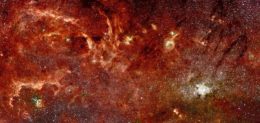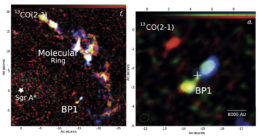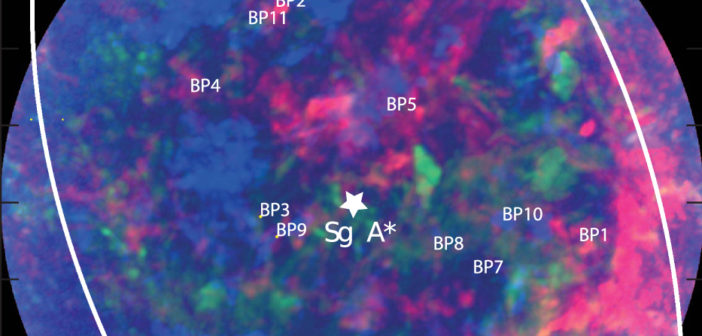Is it possible to form stars in the immediate vicinity of the hostile supermassive black hole at the center of our galaxy? New evidence suggests that nature has found a way.

Infrared view of the central 300 light-years of our galaxy. [Hubble: NASA/ESA/Q.D. Wang; Spitzer: NASA/JPL/S. Stolovy]
Too Hostile for Stellar Birth?
Around Sgr A*, the supermassive black hole lurking at the Milky Way’s center, lies a population of ~200 massive, young, bright stars. Their very tight orbits around the black hole pose a mystery: did these intrepid stars somehow manage to form in situ, or did they instead migrate to their current locations from further out?
For a star to be born out of a molecular cloud, the self-gravity of the cloud clump must be stronger than the other forces it’s subject to. Close to a supermassive black hole, the brutal tidal forces of the black hole dominate over all else. For this reason, it was thought that stars couldn’t form in the hostile environment near a supermassive black hole — until clues came along suggesting otherwise.
Science as an Iterative Process

Very Large Array observations of candidate photoevaporative protoplanetary disks discovered in 2015. [Yusef-Zadeh et al. 2015]
While these observations seemed to indicate that stars might, even now, be actively forming near Sgr A*, they weren’t conclusive evidence. Follow-up observations of these and other signs of possible star formation were hindered by the challenges of observing the distant and crowded galactic center.
Two and a half years later, Yusef-Zadeh and collaborators are back — now aided by high-resolution and high-sensitivity observations of the galactic center made with the Atacama Large Millimeter-Submillimeter Array (ALMA). And this time, they consider what they found to be conclusive.

ALMA observations of BP1, one of 11 bipolar outflows — signatures of star formation — discovered within the central few light-years of our galaxy. BP1 is shown in context at left and zoomed in at right; click for a closer look. [Yusef-Zadeh et al. 2017]
Unambiguous Signatures
The authors’ deep ALMA observations of the galactic center revealed the presence of 11 bipolar outflows within a few light-years of Sgr A*. These outflows appear as approaching and receding lobes of dense gas that were likely swept up by the jets created as stars were formed within the last ~10,000 years. Yusef-Zadeh and collaborators argue that the bipolar outflows are “unambiguous signatures of young protostars.”
Based on these sources, the authors calculate an approximate rate of star formation of ~5 x 10-4 solar masses per year in this region. This is large enough that such low-mass star formation over the past few billion years could be a significant contributor to the stellar mass budget in the galactic center.
The question of how these stars were able to form so near the black hole remains open. Yusef-Zadeh and collaborators suggest the possibility of events that compress the host cloud, creating star-forming condensations with enough self-gravity to resist tidal disruption by Sgr A*’s strong gravitational forces.To verify this picture, the next step is to build a detailed census of low-mass star formation at the galactic center. We’re looking forward to seeing how this field has progressed by the next time we report on it!
Citation
F. Yusef-Zadeh et al 2017 ApJL 850 L30. doi:10.3847/2041-8213/aa96a2



2 Comments
Pingback: New stars forming near MW's SMBH Sgr A*
Pingback: Professor Yusef-Zadeh: Infant Stars Surprisingly Near Galaxy’s Supermassive Black Hole – CIERA